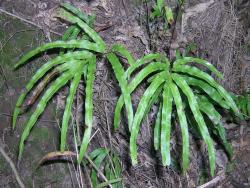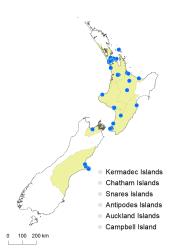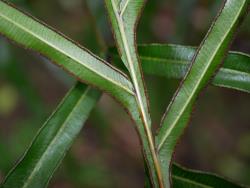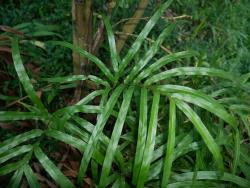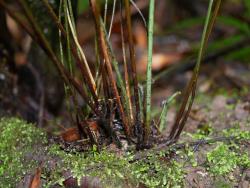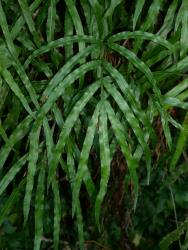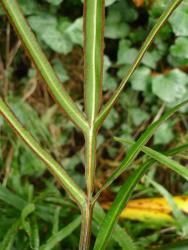- Taxon
- Gallery
Rhizomes short-creeping, up to 90 mm long (in herbarium specimens), scaly. Rhizome scales narrowly ovate, 1.5–2.5 mm long, 0.2–0.3 mm wide, dark brown, concolorous, entire. Fronds 450–1320 mm long. Stipes 220–940 mm long, red-brown proximally at maturity, yellow-brown distally, glabrous or with a few scales proximally. Rachises yellow-brown, winged in distal half, glabrous. Laminae 1-pinnate distally, 1-pinnate-pinnatifid proximally, 175–475 mm long, 100–400 mm wide, broadly ovate, mid-green on both surfaces, coriaceous, glabrous. Primary pinnae in 2–7 pairs with a long terminal pinna, not overlapping; the longest at or near base, 135–430 mm long, 7–18 mm wide (not including secondary pinnae), narrowly ovate to narrowly elliptic, usually slightly falcate or rarely straight; pinna apices acuminate, margins irregularly serrate in sterile portions; distal pinnae long-decurrent at base, proximal pair stalked. Basal 1–2 pairs of pinnae divided almost to the base into 1–3 secondary pinnae arising only on basiscopic side; longest secondary pinnae 70–275 mm long, 7–13 mm wide. Veins free. Sori continuous along most of the sides of the primary pinnae.
Pteris cretica is distinguished by its short-creeping rhizomes and broadly ovate, glabrous laminae that are 1-pinnate distally and 1-pinnate-pinnatifid proximally. There are 2–7 pairs of pinnae, the proximal 1–2 pairs bearing 1–3 secondary pinnae on the basiscopic side only. It is similar to P. multifida, but the latter has smaller, somewhat dimorphic fronds, the proximal primary pinnae bear at least one pair of secondary pinnae that arise on both the acroscopic and basiscopic sides, and the rachis is winged for most or all of its length.
North Island: Auckland, Volcanic Plateau, Taranaki, Southern North Island.
South Island: Sounds-Nelson, Canterbury.
Altitudinal range: 5–400 m.
Pteris cretica is naturalised in many lowland sites from Great Barrier Island to Banks Peninsula, mostly in urban areas or near human habitation. It has also been observed near Gisborne (see iNaturalist 26901808) and Dunedin (see iNaturalist 5486712), but not yet collected, and these localities are not recorded on the distribution map.
A widely cultivated species, which occurs naturally in warm temperate and tropical regions from the Mediterranean and Africa to China and Japan (Crouch et al. 2011), and in Hawai‘i (Palmer 2003). Naturalised in the southern USA, Central and South America (Mickel & Smith 2004), and an occasional escape from cultivation in New South Wales (Kramer & McCarthy 1998) and many other places.
Brownsey (1981). Voucher CHR 318544, 1977.
Pteris lomarioides was described by Colenso (1881) from a single sterile specimen collected by an acquaintance near Tapuaeharuru, Taupō. Cheeseman (1906) stated that it “is proved by the type specimen in Mr Colenso’s herbarium to be the widely distributed P. cretica Linn.”. However, the morphology of this specimen suggests that it may belong to P. parkeri, a species which had not been distinguished from P. cretica when Cheeseman was writing. It is included here in the synonymy for P. parkeri.
The species in New Zealand currently identified as P. cretica (Brownsey 1981; Brownsey in Webb et al. 1988; Brownsey & Smith-Dodsworth 2000) was first collected by Alan Esler in Remuera, Auckland in 1977. However, it differs from the type of P. cretica (LINN 1246.7) in having the rachis winged in at least the distal half, rather than being unwinged throughout, or winged only between the uppermost pair of pinnae and the apical pinna. In this regard the plant in New Zealand is very similar to P. umbrosa R.Br. from Australia. However that species differs in having acroscopic and basiscopic secondary pinnae on the proximal pinnae, whereas the New Zealand plant only has basiscopic secondary pinnae. The Pteris cretica aggregate is known to comprise sexual and apomictic taxa at different ploidy levels (Jaruwattanaphan et al. 2013), and further investigation is needed to determine the status and identity of New Zealand plants. Until then, the name P. cretica is retained here to avoid further confusion.



